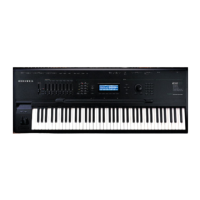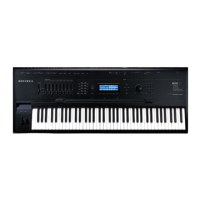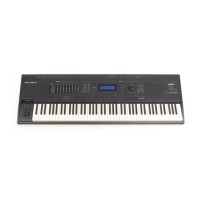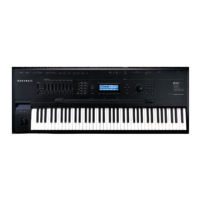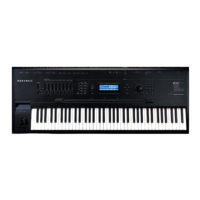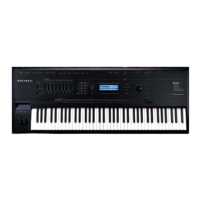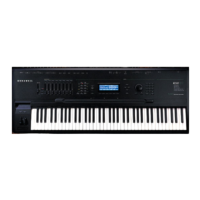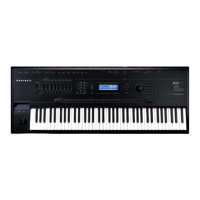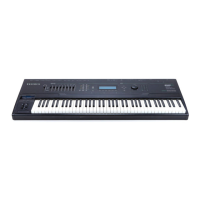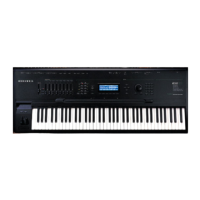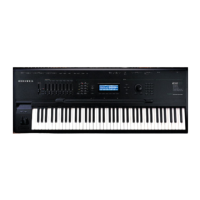DSP Functions
Introduction to Algorithm Programming
14-2
Once you know which algorithm you’re going to work with, you’ll assign various DSP
functions to each of the stages of the algorithm. These stages, as you recall, are represented by
the rectangular blocks you see on the ALG page. The arrows pointing down at the blocks
represent control inputs that affect the behavior of the DSP functions. For each arrow, there’s a
page of parameters controlling some aspect of the DSP function’s behavior. Every DSP function
has at least one control input; several have two or three.
The ALG page is where you select algorithms and assign DSP functions to the algorithm’s
various stages. To assign a DSP function, move the cursor to select the stage you want to
modify, then use any data entry method to scroll through the list of available DSP functions for
that stage. You’ll normally hear the effect of each selection as soon as you make it. If you don’t
hear a difference, it’s because the function’s control parameters aren’t set to significant values.
Once you adjust some of these parameters, the function will have a noticeable effect on the
sound. Keep in mind that not all DSP functions are available at every stage of every algorithm.
When you have each stage of the current algorithm set up to your liking, you can begin to
program the control inputs of each DSP function. This is done by selecting the control input
page(s) for the currently selected DSP function, and adjusting the parameters on the page.
There are two ways to select the control input pages: you can move the cursor to select the DSP
function you want to tweak, and press EDIT. The selected DSP function’s control input page
will appear (if it’s a multi-stage DSP function, its first control input page will appear). Or you
can use the soft buttons to select the pages. The PITCH soft button always selects the pitch
control input page, since the first stage of every algorithm is invariably the pitch control. The
F1—F4 soft buttons select the control input pages corresponding to the remaining four arrows,
which point down at the subsequent four variable control inputs.
Each control input page contains several parameters, which affect some aspect of the behavior
of the DSP function named on the top line of the page. Most of these parameters are the
common DSP control parameters; for a review, see “Common DSP Control Parameters” in
Chapter 6.
The possibilities are truly enormous, given the number of different combinations of functions
you can assign to any particular layer (not to mention multi-layer programs, each layer of
which has its own algorithm). You can create completely new sounds just by tweaking the
parameters on the control input page for a single DSP function. When you begin adjusting
these parameters, it’s a good idea to start with all of them set to 0 (or the value that minimizes
their effects), then adjust them one by one. This will help you understand exactly what effect
each parameter has, and will give you an idea of the variety of effects each parameter can
produce. Then you can start combining the effects of multiple parameters, and quite possibly
take your sound in a whole new direction. You’ll quickly become familiar with the control
input pages for the DSP functions, since most of them contain the same parameters, with just a
few variations. You’ll find that they all look much alike. The top line of each page, however, will
indicate which DSP control input it represents (PITCH, or F1–F4).
EditProg:ALG|||||||||||||||<>Layer:1/1||
||||||||||||||||||||||||||||||||||||||||
||||||||||||||||||||||||||||||||||||||||
errR®rrte11231111112311111123114errR®rt|
dPITCH|gkHIFREQ|STIMULATOR|||||0kAMP||gh
CVVVVVVBCVVVVVVVVVVVVVVVVVVVVVVBCVVVVVB|
||||||||||||||||||||||||||||||||||||||||
<more||F1|FRQ|F2|DRV|F3|AMP|F4|AMP|more>
F1
FREQUENCY
CONTROL
PARAMETERS
PITCH
CONTROL
PARAMETERS
F2
DRIVE
CONTROL
PARAMETERS
F3
AMP
CONTROL
PARAMETERS
F4
FINAL AMP
CONTROL
PARAMETERS
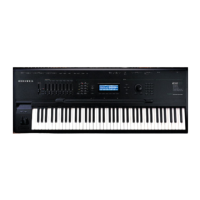
